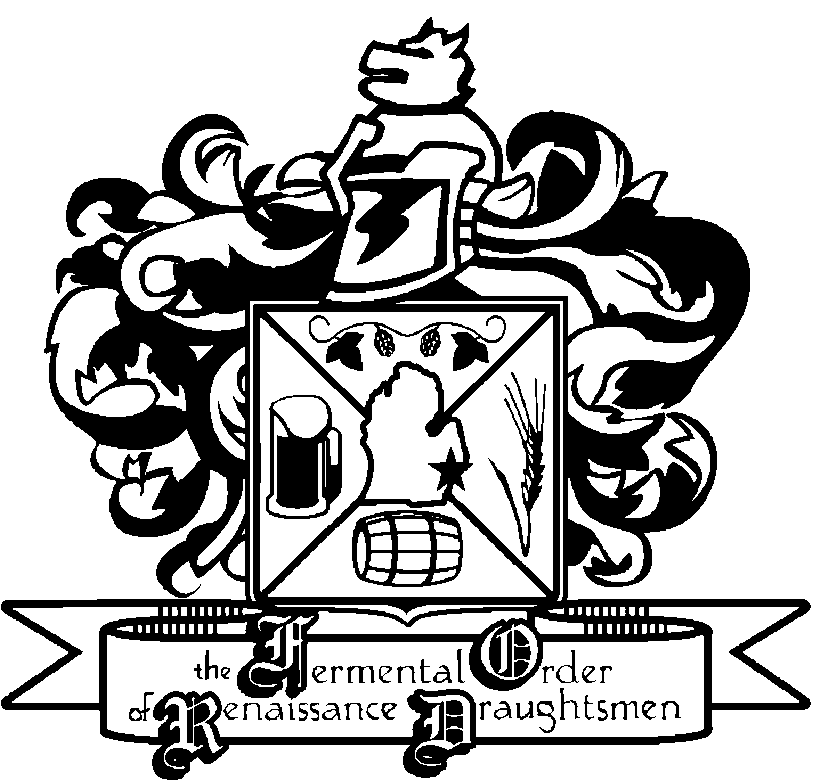



| 
| 
|
| January 1998 | Fermental Order of Renaissance Draughtsmen | Vol. 6 - No. 1 |
In this issue:
|
|

The next meeting will be held on Wednesday, January 28th at our usual club hangout, Chelsea's. For those of you who are new to the club, Chelseas is located on Van Born between Telegraph and Southfield (midway, on the North side). Their address is 22120 Van Born and their phone number is 313-278-0888.
As the new editor of the newsletter, I've taken the liberty of making a few changes. The biggest change, at least to those of you who get the newsletter electronicly, is the format. I changed it from a Word document to an HTML web page. I'm hoping this change will decrease the amount of time necessary to download the newsletter and print it out. Most of the other changes are quite small. I've added a short index at the beginning of the newsletter. I also added a new article that I hope will become a regular feature... "The Brew Review". In this column, I will pick a beer to review each month. I'm going to try to keep the beer to the same style as that month's competition. I'll include tasting notes, a little history about the style and/or brewery, and a few other odds and ends. Please let me know what you think of these changes and additions. Remember, this is your newsletter. If there are any additional changes that you'd like to see, just tell me... I'm open to suggestions.
In addition, I would like to take this opportunity to try to encourage you to write an article for the newsletter. If you visit a new brewpub or brewery, or if you try a new beer, put a few sentences together about it and send it to me. It doesn't have to be long. Or maybe you're a gadget geek and you've found something that you think is great... write a small article about it and share the information with your fellow brewers. If you have a favorite food recipe that includes beer, send it to me. If you take pictures that are in any way beer-related, I can scan them and include them in the newsletter. Now that Sue Merritt has graduated from Beer Mooch to Club Photographer, we'll probably have more pictures in the newsletter from all of our club events.
Okay, enough of that. If you do decide to write an article for the newsletter, here is the schedule:
| 1998 Newsletter Schedule | ||
| Meeting Date | Newsletter Published | Articles Due |
| February 24 (T) | February 17 (T) | Friday, February 13 @ 3pm |
| March 25 (W) | March 18 (W) | Monday, March 16 @ 3pm |
| April 28 (T) | April 21 (T) | Friday, April 17 @ 3pm |
| May 27 (W) | May 20 (W) | Monday, May 18 @ 3pm |
| June 23 (T) | June 16 (T) | Friday, June 12 @ 3pm |
| July 22 (W) | July 15 (W) | Monday, July 13 @ 3pm |
| August 25 (T) | August 18 (T) | Friday, August 14 @ 3pm |
| September 23 (W) | September 16 (W) | Monday, September 14 @ 3pm |
| October 27 (T) | October 20 (T) | Friday, October 16 @ 3pm |
| November 18 (W) | November 11 (W) | Monday, November 9 @ 3pm |
| December 15 (T) | December 8 (T) | Friday, December 4 @ 3pm |

I recently reviewed the only book on homebrewing at the Dearborn Public Library and found this humorous little gem. Reading it reminded me of how far homebrewing has come during the last several decades.
In the Authors Note, Mr. Beadle does provide a disclaimer that "The beer or wine you make up by using the recipes and procedures in this book will bear little relation to any "home-brew" you may have sampled. The art of brewing at home has advanced so rapidly and become so simplified that procedures being used as recently as 1970 are already outdated."
He goes on to give a good summation of brewing history over the ages and through Prohibition. He then begins discussing ingredients necessary to brew beer. He warns that utilizing hops is too much work when you can get the same flavor from Blue Ribbon hopped-extract. He emphatically warns not to boil the extract, or " you will upset this sugar conversion and cause it to refix at a stage that will not allow the yeast to convert all the malt sugar into alcohol and carbon dioxide."
When the topic of yeast comes up, he is emphatic in his choice to utilize only dried yeast's as the liquid varieties inevitably have "been contaminated and soured or the vials have been broken or damaged during shipment and the contents evaporated." Bummer, dude! And goes further to discourage homebrewers from reclaiming yeast from another batch, as infection was to be the most likely result.
Finally, there is his recipe for Beadlebrew, which he states "is a culmination of three years of effort to produce a beer that has a far richer taste than commercial beer, yet retains the refreshing, thirst-quenching quality inherent in the light lagers. This beer has been widely acclaimed as the best beer ever tasted by those who have sampled it."
Ingredients:
3-pound package dried light malt extract
1 can Blue Ribbon Pale Dry malt syrup
1 level teaspoon acid blend
2 level teaspoon salt
Final specific gravity 1.010
Wow, we have come a long way, baby! This delightful little tomb is available at the Dearborn Public Library.

| Palmer's Pub Review
Fire Academy Brewery & Grill Gabrielle Palmer | 
|
The Fire Academy Brewery & Grill is located on the west side of Wayne Road between Warren and
Ford Road. It is decorated in a "fire department" motif, complete with a real fire engine outfitted with tables so
you can enjoy your meal while sitting in a fire truck! There is also a great mural on the back wall depicting fire
fighters in action. You can see 5 stainless steel serving tanks in the front windows.
The menu consists of the typical brewpub fare, including burgers, sandwiches, pasta, steak and seafood. There
is also a kid's menu. Prices range from $7-15 for an adult's meal. I had the fish and chips along with a bowl of
their special Cheddar Ale soup. Excellent food.
They had 6 beers on tap:
Axe Ale (score: 2.5/5) - a very light-bodied beer; smooth, creamy; fruity esters evident; very low
carbonation. Probably their mainstream beer.
Smoke-Eater Wheat (score: 4/5) - typical wheat haze; clove and banana flavors evident, but mostly
clove; slight citrusy taste; nice light-bodied weizen-style wheat beer; light carbonation. Most flavorful of
their beers.
Chief's Amber Ale (score: 2/5) - dry, roasted flavor... not what I was expecting from an amber ale;
low carbonation; absolutely no hop flavor.
Hook & Ladder Scotch Ale (score: 2.5/5) - sweet, smokey (almost maple?) aroma; slightly smokey flavor; light body; low carbonation.
Pike Pole Porter (score: 2/5) - again, low carbonation; sweet with only a hint of roastiness; kind of bland, especially for a porter.
Sargeant Stout (score: 2.5/5) - slightly sweet; light body... not "stout" enough to be a stout; low carbonation; bland.
Overall, I probably wouldn't go back for their beer if they were a more established brewpub. But since they've only been open for a few months, I'll probably return again at least once or twice in the next year to see if their beers have improved. They are obviously still working some kinks out, like their carbonation problem.
By nine o'clock the majority of brewers had assembled in the kitchen and we enjoyed a hearty eggs/bacon/
toast/juice and coffee start to the day. The second crisis of the day: two separate recipes for Sierra Nevada
Pale Ale clone, one with a calculated IBU in excess of 100. Since this recipe came from a respected homebrew
supplier who loves SNPA more than any other beer, I was in a quandary. A call to the shopkeeper in question
determined that he was out of the shop for the day.
Gary Shewchuk grabbed some brewing books and worked out where the IBU's should be and we went with his
recommendation. Turns out that the recipe in question was assuming a 2-gallon extract boil and then adding that
to 3 gallons of water. The high gravity of the 2 gallon extract boil creates the need for more IBU's since they
are not getting utilized efficiently.
The crowd, fully satiated, moved to the garage to begin the brewing process. We jammed open the grain mill
as much as we dared and ground the grains for the brews. Al Czajkowski and Gary Shewchuck worked together
brewing a partial mash version of Tim's Paranoid Porter and a monstrous Pale Ale, Mike Arend brewed a MF Brown
Ale (what's the MF stand for, Mike?), Tony Treusch and his son Chris brewed with me to create the SNPA clone and
Gabrielle Palmer and Steve Kelly worked on an all-grain Robust Porter. Karl Ziemba and his son Daniel also stayed
the morning to watch the events unfold, as did Joe Tomassi.
I unfortunately used the 5-6 lbs. of powdered grain and paid dearly for this miserable move. Within an hour we
had an absolutely stuck mash. No amount of blowing back into the kettle could dislodge the gunk that the fine
crush created and the temperature continued to drop. Without the ability to recirculate the mash we were stumped.
A quick check of the inventory revealed we had enough grains to start again, so 27 pounds of grain were flung into
my backyard and another 27 reground. From there forward, everything worked well and Second Chance Pale Ale was
created.
Meanwhile, Gabi's Porter was experiencing similar problems. Rather than following my lead, Steve and Gabi
bucketed the mash into another kettle with a false bottom. This worked as well and Pain in the Ass Porter was
created. Meanwhile, Al and Steve chortled as their 20 gallons of partial-mash continued without incident.
Overall, it was a successful day of brewing and we were all weary and cold by the time we could all pitch
our yeast. I left the clean-up for another day and wearily retired to the tub for a long, hot soak. I will
probably hold another brew-off/picnic/taste testing this spring, but not before I fix my maltmill.
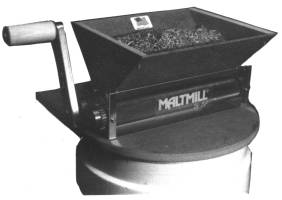 The day started off with me twisting off the adjustment screw on my Malt Mill. I had been turning
it one way for so long I just assumed that it was a cam. Well, I ground five or six pounds at the setting that
it got stuck on and the results were some awfully fine flour. I awaited the arrival of the other brewers and
decided that I would follow whatever the collective determined was the right path.
The day started off with me twisting off the adjustment screw on my Malt Mill. I had been turning
it one way for so long I just assumed that it was a cam. Well, I ground five or six pounds at the setting that
it got stuck on and the results were some awfully fine flour. I awaited the arrival of the other brewers and
decided that I would follow whatever the collective determined was the right path.

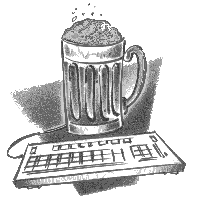 Greetings Beerlings! This may be a very familiar phrase to many of you
who are regulars of the HBD (Homebrewers Digest), one of many resources on the Internet available to homebrewers
worldwide. I won't pretend to be a web expert, nor do I play one on TV, but I know enough to be helpful and
that's where this article is going. I could spend pages and pages on the web and homebrewing but I'll break
it up into smaller articles instead. This first article will avoid actual websites and focus on newsgroups
and maillists.
Greetings Beerlings! This may be a very familiar phrase to many of you
who are regulars of the HBD (Homebrewers Digest), one of many resources on the Internet available to homebrewers
worldwide. I won't pretend to be a web expert, nor do I play one on TV, but I know enough to be helpful and
that's where this article is going. I could spend pages and pages on the web and homebrewing but I'll break
it up into smaller articles instead. This first article will avoid actual websites and focus on newsgroups
and maillists.
The first resource is called the HBD and it is a maillist bulletin board. The digest has undergone 4 "owners" since it started a few years ago, including the AHA (where it almost died an unnatural death) and currently Karl Lutzen (Cat's Meow, Homebrew Favorites, Brew Wares) and our own Pat Babcock. Pat and Karl prefer to be called janitors, rather than owners or managers of the digest for the simple reason that the digest runs itself. Pat and Karl maintain the mailing list that distributes the digest each day, and the hardware that controls the digest. Pat and Karl are much more than janitors, they are very active in the daily operation of the HBD to ensure a seamless program. People write in questions which get stored throughout the day and when the file hits a certain size, the digest gets mailed out to a list of about 3,500 direct subscribers. The digest is a combination of new questions, and answers to previous questions from people who have (or like to think they have) the answers. Topics may include very simple questions from brand new brewers (called newbies), to recipe requests, to detailed technical questions about HSA (Hot Side Aeration) or Alpha Amylase Enzymes or welding stainless steel or building a fridge controller. Regular "celebrities" on the digest include George Fix (author: Principles of Brewing Science), Jack Schmidling (inventer of the malt mill) , Dan Listerman (inventor of the Phil Mill, Phil Chiller, and various other products), Graham Wheeler (English Author), Kinney Boughman (Inventer of Bruheat), and Jim Parker and Brian Rezac of the AHA are regulars as well. Many technical experts in the field of metallurgy, chemistry, microbiology, electronics and a host of others are frequent contributors as well. Many homebrew shop owners and brewers are also on hand to help answer questions. This may sound intimidating, but it is as simple as asking your question as an e-mail and having several thousand people read it. Now the majority of subscribers are known as lurkers, people who read the digest daily, but will never in their life ask a question or post (submit) an answer, this is perfectly ok, these people scan the digest for articles that interest them and learn from others. Sound intriguing? You bet it is.
Now for those of you at Ford who are interested in this, send a profs note to Rich Hampo (rhampo) and he will add you to the distribution list and send you a digest every morning. Rich subscribes directly to the digest, and then in turn forwards it to anyone in the F.O.R.D. club who is interested, this cuts down on Internet traffic in and out of Ford. The articles are listed in order received, and compiled into a single piece of e-mail (or Profs note). I suggest subscribing and reading the digest for a week, and then if you wish, posting (submitting) a question, recipe requests, or an answer to someone else's question.
Now, several rules of "netiquette" must be followed. First off, if you are asking a question, be concise and clear. No one needs to know the history of your brewing background if you are asking for a Guinness clone (but they do need to know if you are an extract or an all-grainer). Be polite. Remember, you are asking for help. Watch your spelling and grammar. This may seem obvious, but lots of people will answer your post just for the sake of pointing out errors without actually offering any help. These people are jerks and unfortunately can be found everywhere. Now, if you are answering a question, the most important rule is to quote the key question being asked, (i.e. Rich Byrnes in HBD 2620 on 1-15-98 asked about using a Nitrogen and CO2 system for dispensing stouts). You may simply cut and paste but if you leave out the question, any attempt at an answer will be confusing. Now, when you answer a question, it helps to qualify your authority to answer. This is as simple as saying "I am a bio-chemical engineer by trade", or "I've brewed 13 Bass Ale clones and this is the one closest to the original", or honestly that you just know the answer because you're smart. People like to know where their answers are coming from. And don't try to pretend to be an expert if you're not. You will get flamed. Flamed you ask? That sounds brutal. Well, it can be. The word flame is synonymous with insulted, and people can get nasty when they're behind a keyboard instead of in front of your face. Flame wars can be entertaining to watch with tempers flaring on all sides, but usually fizzle out pretty quick. Try to avoid them.
If you are outside of Ford, send an e-mail message to request@hbd.org with the word 'subscribe' (skip quotes) in the body of the message to sign up for the list, and conversely unsubscribe if you wish to leave the list. Now, regardless of where you are, to post a question or answer, merely send the message to post@hbd.org and your post will be queued up with all the other posts waiting to be mailed. Information about the HBD may be found at http://hbd.org including a list of contributors who helped resurrect the HBD by contributing financially to Pat and Karl when they launched this current venture. Many thanks to all the homebrewers in the F.O.R.D. club and the A.A.B.G. club who rallied behind Pat with their checkbooks when the cry for help went out. The monies received went to buying new hardware when it was needed.
Here's an example of the contents of todays HBD:
Why Pellets have Higher Utilization than Whole Hops (Charles Burns)
John Bull Wheat Syrup (Wayne_Kozun)
Ceramic heaters and extremely cold temps. (Ralph Link)
Rob & George (michael rose)
Thermometers (Al Korzonas)
Keeping Warm (Ari Shapiro)
Reminder: National Bay Area Brew Off ("Bryan L. Gros")
registering a homebrew club with AHA ("Kevin TenBrink") 
World Cup of Beer (Dave Sapsis)
Re: Blade Shearing and Other Strange Fluid Mechanics (Jim Bents
Costa Rican Beer, Pura Vida (Mark Tumarkin)
more on labels (Mark Tumarkin)
RE: Will any CO2 do? (Margie and Dave Ludwig)
Various stuff (George De Piro)
diacetyl (Andy Walsh)
mixmasher, steam, etc ("David Hill")
Infusion vrs. Step Infusions ("Olin J. Schultz")
Tagline - Changing the Past (Overstreet)
To decoct or not to decoct? (SBireley)
RIMS mashing problems with lager malt (SBireley)
alcoholism ("Michael Gerholdt")
Zima ("Gabi Scharfetter")
RIMS aka Rodney Morris ("Mark Ellis")
Irish moss (Adam Holmes)
Sparge Quittin' Time / 30 minutes of Oxygen (KennyEddy)
Next month: R.C.B. (Rec Crafts Brewing) and other usenet-newsgroup resources for brewing and beer.
| 1st Place: Tyler Barber Style: Barley Wine Score: 49/50 | An exceptional barley wine with the correct balance of malt sweetness, hops and alcohol. The aroma alone was enough to make me fall in love with it. The only fault we could find was a slight haze, even at room temperature. |
| 2nd Place: Gabrielle Palmer Style: Raspberry Nutmeg Belgian Score: 41/50 | A very good beer. It started with pleasant raspberry aroma, a nice color and a good head. The flavor was tangy with a tasty balance of fruit, malt and hops. |
| 3rd Place: Chris Frey Style: Barley Wine Score: 40/50 | A heady aroma, good malt/hop balance and an absence of off flavors. However, it was a bit too sweet. Perhaps not attenuated enough? |
Hail to the Ales (AHA Competition):
The Hail to the Ale entries (AHA style categories #5a & b, #6a, b & c) will be judged on Tuesday, January 20th, after the deadline
for this newsletter.
| 1998 Competition Schedule | ||
| Date | Competition | AHA Style Categories |
| January 28 (W) | Stout Bout (AHA) | #11 a, b, c, d & e |
| February 24 (T) | Mild & Brown Ale Competition | #4 a, b, c & d |
| March 25 (W) | Classic Pilsner Competition (AHA) | #15 a, b & c |
| April 28 (T) | Brewer's Choice Competition | Free for all |
| May 27 (W) | Alt/Kolsch Competition | #18 a & b |
| June 23 (T) | Weiss is Nice Competition (AHA) Label Contest |
#19 a, b, c & d |
| July 22 (W) | Summer Light Beer (Lawnmower) Competition | Free for all |
| August 25 (T) | Best of Fest Competition (AHA) | #17 a & b |
| September 23 (W) | Fruit/Lambic Competition | #3 a, b & c and #21 a & b |
| October 27 (T) | If It's Not Scottish... Competition (AHA) | #8 a, b & c and #10 b |
| November 18 (W) | Porter Competition | #9 a & b |
| December 15 (T) | Holiday Ale/Barleywine Competition
Also, entries due for January 1999 Hail to Ale Competition (AHA) |
Free for all |
This month's competition is Stout (AHA style categories #11 a, b, c, d & e). Please bring your stout entries
to this month's meeting. We'd like to make a good showing! If you have an entry, but can't make the meeting, call me at
(313)699-5436 and we can make other arrangements.
February's Competition - Brown Ales:
Just a heads up - Start brewing now to make February's contest.
Boulder, Colo., Dec. 17, 1997 - December 2, 1997 was a day of celebration for
Michigan homebrewers, even though most of them didn't realize it.
On December 2, Governor John Engler signed House Bill 4850. This new law permits
homebrewing and allows homebrewers to give away up to 20 gallons of their brew.
Most Michigan homebrewers had no idea that homebrewing wasn't statutorily
recognized. A few years ago, the American Homebrewers Association® discovered
that homebrewing wasn't recognized by some state governments and could be
considered illegal. Since then, the AHA has worked with homebrewers in Michigan
and other states to legalize the hobby.
The AHA supported Michigan State Representative David Anthony, who sponsored
HB 4850. Rex Halfpenny, publisher and editor of the Michigan Beer Guide, worked
with the AHA and helped the effort move forward. The AHA is a division of the
Association of Brewers that provides information to its members and the general
public on the art and science of homebrewing.
In 1978, 45 years after prohibition ended, the federal government statutorily
recognized homebrewing. Most states then wrote statutes into their own laws
recognizing homebrewing. A few states, including Michigan, did not.
There was never a law in Michigan specifically stating that people couldn't
homebrew, but the old statute did specifically state that people could make
wine and cider at home. "It kind of left homebrewers out in the cold,"
Halfpenny said.
Michigan State Senator Christopher Dingell, a lawyer and homebrewer, saw a
different problem. Under Michigan law, giving away homebrew was illegal; it
was considered selling it. This meant that giving homebrew to a friend or
entering it in a competition without holding a license and paying taxes on
the beer was illegal. Dingell wrote Senate Bill 505, which made it legal
for homebrewers to give away some of their beer. SB 505 was later attached
to the newly adopted HB 4850.
Although the new provision doesn't state that homebrewers can now enter
their beers in competitions, Halfpenny feels it is implied. "I would infer
that this opens the door for taking homebrew and giving it to your friends
and entering competitions," he said. "Both of those things are actually
giving it away."
The AHA helped Halfpenny in his effort to legalize homebrewing by rallying
the people in Michigan, sending mass e-mails and faxes to homebrewers and
sending information packets to Michigan legislators. The AHA urged homebrewers
to get their local officials involved.
"The American Homebrewers Association placed phone calls to bill sponsors,
but it was mainly up to the citizens of the state because it's their voices
that really counted," said Mark Snyder of the Association of Brewers.
AHA administrator, Brian Rezac, traveled to Michigan and spoke at the Michigan
Homebrewers Rally to draw attention to the campaign. "Michigan is a perfect
example of what we need to do to legalize homebrewing in every state," Rezac
said. "We need someone to spearhead it, support from legislators and a
well-executed grassroots effort. This story could be used as a How to Legalize
Homebrewing in Your State primer."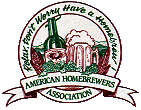 Michigan Homebrewers Toast New Law
Michigan Homebrewers Toast New Law
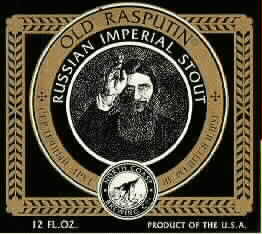
| 
| 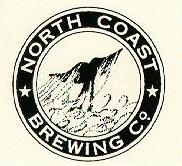
|
Old Rasputin Russian Imperial Stout is brewed by North Coast Brewing Company in Fort Bragg, California, USA.
They have a virtual taproom at http://ncoast-brewing.com/taproom.html
About the Style:
History:
Looks & Taste:
Beer & Food:
Rating:
Quaffable Quotes:
Imperial stouts are the stoutest of the stout family. They are malty, hoppy and big! Everything I love about beer.
They were first brewed in the late 18th century in Britian for export to Russia. The Slavic nations preferred a beer that
was heavy, flavorful and highly alcohic. Imperial stouts are usually a black color with an alcohol content exceeding
8 percent. The rich malty flavor is balanced with assertive hopping. Roasted malt flavor and bitterness contribute to the
overall complexity of this marvelous beer.
Gregory Rasputin was a Siberian monk with a knack for hypnotism. His rivals tried to kill him by poisoning, stabbing
and beating him. When that didn't work, they shot him three times in the back, rolled him up in a rug and threw him into
a hole in the ice of a nearby river. His body was found two days later. It was determined that the cause of death was
drowning. Now that's tenacity! Legends attribute Rasputin's courage and toughness to his love of imperial stouts.
Among their many awards, North Coast Brewing Company has won gold medals at the 1995 and 1996 World Beer Championship in
Chicago, as well as a gold medal at the 1996 World Beer Cup in Colorado for their Old Rasputin Russian Imperial Stout.
Old Rasputin has a wonderful, thick, brown head and a rich, deep, black color. It has a strong, thick and creamy
malt flavor that is both sweet and bitter, with a mild roasted/burnt aftertaste and a roasty aroma. This imperial
stout has a full-bodied consistency with an alcoholic warmth that will bring a smile to your face and a nice warm glow
to your cheeks on a cold winter night. It finishes with a big hop bitterness that lingers. Brussels lace stays on
the sides of the glass right to the bottom. Old Rasputin is an excellent example of the imperial stout style.
Although Old Rasputin can be enjoyed entirely by itself, it goes well with moderately sweet deserts. Try it over some
good vanilla icecream for an amazing taste sensation!




 (out of 5)
(out of 5)
"I like beer. On occasion, I will even drink beer to celebrate a major event such as the fall of communism or the fact
that the refrigerator is still working." -Dave Barry
| Ye Olde Brew News
published by the F.O.R.D. Homebrew Club | |
| Editor:
Gabrielle Palmer
Contributing Writers:
Club Officers:
|
F.O.R.D. is a private, non-profit organization of homebrewers. Its main goal is to share information
regarding technique, equipment and skill required to brew quality homemade beer.
Correspondence should be directed to:
Work: 313-337-1642
(w) chris.frey-ford@e-mail.com
Visit our website at: http://www.be.ford.com/brewery/
current circulation... 130 |